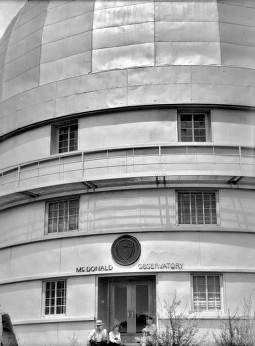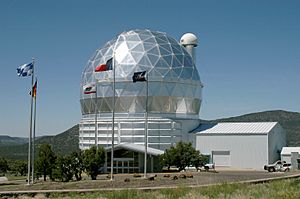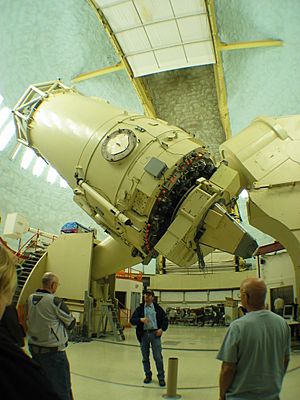McDonald Observatory facts for kids
Quick facts for kids McDonald Observatory |
|
|---|---|
| Location | Jeff Davis County, Texas |
The McDonald Observatory is a special place where scientists study the stars and planets. It's an astronomical observatory located in Jeff Davis County, Texas, near a small community called Fort Davis. This amazing facility sits on top of two mountains, Mount Locke and Mount Fowlkes, in the Davis Mountains of West Texas. It's part of The University of Texas at Austin and helps us learn more about space.
The observatory also creates StarDate, a daily radio show. These short segments talk about cool astronomy topics. You can hear StarDate on many radio stations across the country, reaching about 400 different places!
Contents
History of McDonald Observatory
The McDonald Observatory was made possible by a generous gift from a Texas banker named William Johnson McDonald. When he passed away in 1926, he left about $1 million of his money to The University of Texas at Austin. He wanted them to use it to build an observatory.
Even though some of McDonald's relatives tried to stop it, the university eventually received about $800,000. Construction then began on Mount Locke. The first big telescope, now called the Otto Struve Telescope, was officially opened on May 5, 1939. At that time, it was the second largest telescope in the entire world! For many years, The University of Chicago helped run the observatory. But in the 1960s, The University of Texas at Austin took over completely.
Today, scientists at McDonald Observatory study many exciting things. They look for and try to understand planetary systems (planets orbiting other stars). They also study stars, the space between stars, and galaxies far away. One big project is the Hobby-Eberly Telescope Dark Energy Experiment (HETDEX). This project is trying to figure out what dark energy is, which is a mysterious force in the universe.
Who Led the Observatory?
Here are some of the people who have been in charge of the McDonald Observatory:
- Otto Struve (1932–1950)
- Gerard Peter Kuiper (Sept. 1947–Dec. 1949, Sept. 1957–Mar. 1959)
- Bengt Georg Daniel Strömgren (Jan. 1951–Aug. 1957)
- William Wilson Morgan (Apr. 1959–Aug. 1963)
- Harlan James Smith (Sept. 1963–1989)
- Frank N. Bash (1989–2003)
- David L. Lambert (2003–2014)
- Taft E. Armandroff (2014–present)
Exploring the Observatory
McDonald Observatory has many different tools to help scientists. These tools can take pictures and study light from space, both visible light and infrared light. It also has the first station that uses lasers to measure the distance to the Moon! The observatory works closely with the astronomy department at The University of Texas at Austin.
The Davis Mountains are a great place for an observatory. The peaks are high and dry, which means the night skies are very dark and clear. These conditions are perfect for looking at distant objects in space.
The Otto Struve Telescope was the first large telescope built here. It opened in 1939 and is on Mount Locke, about 2,070 meters (6,790 feet) high. The top of Mount Locke is the highest point on Texas highways! The Harlan J. Smith Telescope is also on Mount Locke and was finished in 1968.
The Hobby-Eberly Telescope (HET) was opened in 1997. It's on Mount Fowlkes, about 2,030 meters (6,660 feet) above sea level. This telescope is a team effort, run by The University of Texas at Austin and other universities. After some upgrades, the HET is now one of the largest telescopes in the world! It's special because it was much cheaper to build than other telescopes its size. This is because it's designed to be really good at studying the light from objects in space.
The University of Texas at Austin is also helping to build an even bigger telescope called the Giant Magellan Telescope. People from McDonald Observatory are very involved in this huge project.
Telescopes at McDonald Observatory
The observatory uses four main research telescopes to study the universe:
- The 10-meter (390-inch) Hobby-Eberly Telescope on Mount Fowlkes.
- The 2.7-meter (107-inch) Harlan J. Smith Telescope on Mount Locke.
- The 2.1-meter (82-inch) Otto Struve Telescope on Mount Locke.
- A 0.76-meter (30-inch) telescope on Mount Locke, used for taking large pictures of space.
There's also a 0.91-meter (36-inch) telescope that used to be for research. Now, it's used for programs where visitors can look through it!
Other Telescopes Here
The two mountains also host other special instruments:
- The 1.2-meter (47-inch) Monitoring Network of Telescopes (MONET) North Telescope on Mount Locke. It's like a twin to a telescope in South Africa.
- Two 1.0-meter (39-inch) telescopes and one 0.4-meter (16-inch) telescope on Mount Fowlkes. These are part of a global network of telescopes.
- The McDonald Laser Ranging System (MLRS) uses a 0.76-meter (30-inch) telescope on Mount Fowlkes. It shoots lasers at satellites and the Moon to measure distances.
- A 0.5-meter (20-inch) telescope on Mount Locke, owned by Boston University, studies the Earth's upper atmosphere.
- The 0.4-meter (16-inch) Robotic Optical Transient Search Experiment (ROTSE) telescope on Mount Fowlkes looks for flashes of light from powerful gamma-ray bursts.
Climate at the Observatory
The observatory has a semi-arid climate, which means it's usually dry. Winters are cool and dry, while summers are hot and wetter.
- Coordinates: 30°42′19″N 104°01′24″W / 30.70528°N 104.02333°W
- Elevation: 2,070 meters (6,790 feet)
| Climate data for Mount Locke, Texas (Jan 1, 1935–Mar 31, 2013) | |||||||||||||
|---|---|---|---|---|---|---|---|---|---|---|---|---|---|
| Month | Jan | Feb | Mar | Apr | May | Jun | Jul | Aug | Sep | Oct | Nov | Dec | Year |
| Record high °F (°C) | 80 (27) |
79 (26) |
88 (31) |
94 (34) |
96 (36) |
104 (40) |
100 (38) |
104 (40) |
96 (36) |
94 (34) |
82 (28) |
80 (27) |
104 (40) |
| Mean daily maximum °F (°C) | 53.5 (11.9) |
56.9 (13.8) |
63.7 (17.6) |
71.4 (21.9) |
78.6 (25.9) |
84.5 (29.2) |
82.7 (28.2) |
81.3 (27.4) |
76.6 (24.8) |
70.5 (21.4) |
61.2 (16.2) |
54.4 (12.4) |
69.6 (20.9) |
| Daily mean °F (°C) | 42.7 (5.9) |
45.4 (7.4) |
51.0 (10.6) |
58.3 (14.6) |
65.5 (18.6) |
71.4 (21.9) |
70.8 (21.6) |
69.8 (21.0) |
65.5 (18.6) |
59.3 (15.2) |
50.0 (10.0) |
44.0 (6.7) |
57.8 (14.3) |
| Mean daily minimum °F (°C) | 32.0 (0.0) |
33.9 (1.1) |
38.2 (3.4) |
45.2 (7.3) |
52.4 (11.3) |
58.2 (14.6) |
58.9 (14.9) |
58.4 (14.7) |
54.4 (12.4) |
48.0 (8.9) |
38.7 (3.7) |
33.6 (0.9) |
46.0 (7.8) |
| Record low °F (°C) | −10 (−23) |
−6 (−21) |
4 (−16) |
11 (−12) |
26 (−3) |
36 (2) |
40 (4) |
40 (4) |
29 (−2) |
13 (−11) |
8 (−13) |
−2 (−19) |
−10 (−23) |
| Average precipitation inches (mm) | 0.68 (17) |
0.49 (12) |
0.40 (10) |
0.50 (13) |
1.63 (41) |
2.49 (63) |
3.83 (97) |
3.69 (94) |
2.95 (75) |
1.61 (41) |
0.61 (15) |
0.60 (15) |
19.46 (494) |
| Average snowfall inches (cm) | 1.9 (4.8) |
0.8 (2.0) |
0.2 (0.51) |
0.1 (0.25) |
0.0 (0.0) |
0.0 (0.0) |
0.0 (0.0) |
0.0 (0.0) |
0.0 (0.0) |
0.1 (0.25) |
0.4 (1.0) |
1.2 (3.0) |
4.7 (12) |
| Average precipitation days (≥ 0.001) | 3.75 | 3.13 | 2.62 | 2.77 | 5.93 | 8.75 | 12.00 | 11.56 | 9.32 | 5.91 | 2.94 | 3.29 | 71.45 |
| Source: Western Regional Climate Center, Desert Research Institute | |||||||||||||
Visiting McDonald Observatory
The Frank N. Bash Visitors Center is a great place to start your visit. It's located between Mount Locke and Mount Fowlkes. Inside, you'll find a gift shop and a fun exhibit hall with interactive displays.
The Visitors Center offers daily live viewings of the Sun in a large theater. You can also take tours to see the observatory's biggest telescopes up close. In the evenings, they host exciting star parties every Tuesday, Friday, and Saturday. During these parties, visitors can look through many different telescopes in the Rebecca Gale Telescope Park and see amazing things in the night sky.
If you want an even more special experience, you can book a "Special Viewing Night." On these nights, you can look directly through the eyepieces of the 0.9-meter and Otto Struve (2.1-meter) telescopes. It's a fantastic way to see the universe up close!
Images for kids
See also
 In Spanish: Observatorio McDonald para niños
In Spanish: Observatorio McDonald para niños












